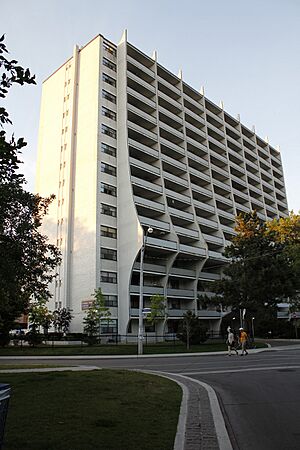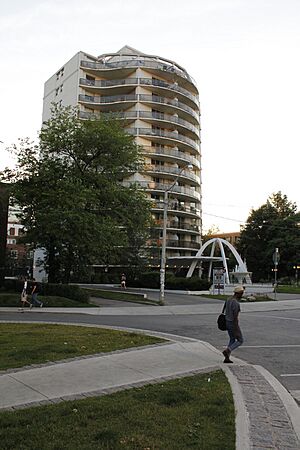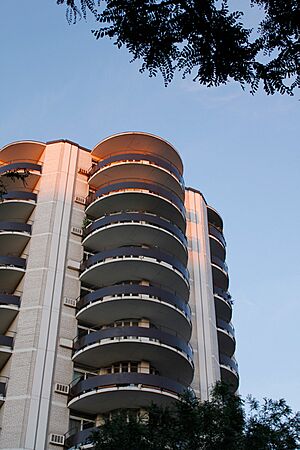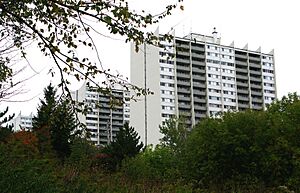Uno Prii facts for kids
Quick facts for kids
Uno Prii
|
|
|---|---|
| Born | February 28, 1924 |
| Died | November 27, 2000 Toronto, Ontario, Canada
|
| Nationality | Estonian-Canadian |
| Occupation | Architect |
| Buildings | The Vincennes, Prince Arthur Towers, 44 Walmer Road, Alan Brown Building |
Uno Prii (born February 28, 1924 – died November 27, 2000) was an architect from Estonia who later became a Canadian citizen. An architect is someone who designs buildings. Uno Prii designed about 250 buildings. Many of these buildings are in Toronto, Canada. He also designed buildings in other parts of southern Ontario and the United States.
Some of his most famous buildings are apartment buildings in a Toronto area called The Annex. These buildings have cool, curvy shapes. Examples include The Vincennes at 35 Walmer Road (built in 1966) and Prince Arthur Towers at 20 Prince Arthur Avenue (built in 1968). Other notable buildings are Brazil Towers and 44 Walmer Road.
Contents
Uno Prii's Early Life
Uno Prii grew up in Estonia. His father was also an architect and builder. In 1943, Uno Prii moved to Finland. The next year, in 1944, he moved to Stockholm, Sweden. He trained and worked there as a civil engineer. A civil engineer designs and builds things like roads and bridges.
In 1950, he moved to Canada. He came to Toronto to study architecture. In 1955, he graduated with honors from the University of Toronto School of Architecture. He worked with a firm called Fleury & Arthur every summer until he graduated.
Uno Prii's Career as an Architect
Uno Prii started his own architecture company in 1957. Having his own company allowed him to design buildings in his own unique way. At that time, most buildings were designed in a style called Modernism. This style used straight lines and simple shapes. Prii wanted to do something different.
In the 1960s, many people moved to Toronto. Thousands of immigrants arrived, and many young people (called Baby boomers) started working. Because of this, living in apartments became very popular.
Exciting Designs of the 1960s
The 1960s were Uno Prii's most creative time. During this period, he finished many buildings that showed off his famous curvy shapes and artistic details. He used new building methods, like "slip-form concrete molds." These molds could slide up buildings as concrete was poured. This helped him create his unique, curvy designs.
Some people didn't like his bold ideas and chose other architects. But a builder named Harry Hiller, who was from Poland, was open to Prii's vision. Together, Prii and Hiller created some of Prii's most well-known apartment buildings. These include 35 and 44 Walmer Road, and 20 Prince Arthur Avenue.
The Vincennes Building
Uno Prii's design for The Vincennes at 35 Walmer Road was one of his most daring projects. The building has a gently curved front. It features a dramatic, elegant flare on the fifth floor, which makes the balconies deeper. The outside of the building is white. Many of his special towers from the 1960s were also white.
The building has tall, thin shapes that point towards the sky. Prii also designed a wide, curved cover over the entrance. This cover has many small holes around its edge. Harry Hiller finished building The Vincennes in 1966.
Prince Arthur Towers
At 20 Prince Arthur Avenue, Prii and Hiller created what many consider Prii's most expressive design. This single 23-story apartment tower was finished in 1968. It looks very tall because of its bold, upward-curving concrete front.
What look like flying buttresses (supports that stick out from a wall) create a huge, flared base. These parts stick out from the main building. They not only make the tower look unique but also help it stand strong against the wind. These "flyers" blend into the building and continue past the roof, forming a crown at the top.
The sides of the building are plain concrete walls. They are smooth and white, except for a black stripe that runs down the wall. This stripe opens up into a large arch at the bottom. A part of the building behind the arch is painted black to create a strong contrast. The white walls are set off by blue balcony railings on the front and back of the building. The simple design of the side walls makes the tower look even more like a sculpture.
In 1969, Uno Prii also completed the Jane-Exbury Towers. These are five white towers in North York, a suburb of Toronto. They are built one after another and have a similar curvy design. They remind people of both The Vincennes and the Prince Arthur Towers. The roofline and side walls with an arch at the bottom are like the Prince Arthur Towers. The outward flare above the lower floors is similar to The Vincennes. The way the towers are spread out on a large suburban area, surrounded by green spaces, makes them look very impressive.
44 Walmer Road
Prii worked with Harry Hiller again on 44 Walmer Road. This building was finished in 1969. Its white front is light and very rounded. This 12-story apartment building features circular and straight line designs. It has a half-circle canopy over the driveway, with large holes around its edges.
Prii also designed a fountain in front of the building. It has two curved arches that cross over a round pool. This connects with the canopy design. Water sprays up from a large concrete shape that looks like a champagne glass. The water then spills into the pool.
The building used to have special balcony railings with curvy, circle patterns. These were part of its unique look. However, when the balconies needed repairs, the owner decided not to put them back. In July 2001, plain clear glass railings were installed instead. Many people, including tenants, neighbors, Prii's family, and architects, protested this change.
Changes in the 1970s and Retirement
By the early 1970s, Uno Prii started using more straight lines in his designs. He began to use old images for decoration. He created designs that looked like post and lintel structures (two upright posts with a beam across the top) using concrete slabs. He also made stylized faces inspired by Moai statues (the large stone statues on Easter Island) and straight-lined human figures.
During this time, he also changed the materials he used. He moved from shiny white bricks to more natural colors like brown and terracotta (a brownish-red clay). He also switched from smooth white concrete to textured, gray concrete surfaces.
In the early 1980s, Uno Prii retired and closed his design company.
Uno Prii's Style and How He Was Seen
Prii worried that large apartment buildings often looked boring and similar. He felt that plain, rectangular towers didn't give people a sense of identity. He believed that apartment buildings with unique and interesting outsides could help people living there feel more connected. Clients who wanted something different from the repetitive, geometric International style came to him.
His most famous buildings were built in the 1960s. They were special and original towers with a sculptural look. Prii’s apartment buildings seemed to be a strong protest against the strict, serious, and humorless Modernist style. In his free time, he enjoyed painting and sculpting. He said these hobbies helped him with his building designs.
Some critics thought his buildings looked strange. Like another architect named Morris Lapidus in the United States, Uno Prii was popular with the public but not always praised by other architects. He didn't receive awards or recognition from his fellow architects. In an interview in 1999, he said that other architects "thought my work just looked funny...they didn’t like me...they didn’t like my work at all." However, he was still proud of his original designs. He believed that "originality is the hardest thing to come by."
But by the late 1980s and early 1990s, a new group of architects and people interested in architecture rediscovered Uno Prii's work. Architects like Michael McClelland, John Shnier, Larry Richards, Joe Lobko, and Catherine Nasmith have talked about how important his work is. As of 2007, 16 buildings designed by Prii have been listed in Toronto's Inventory of Heritage Properties. This means they are recognized as important historical buildings.
Uno Prii's Buildings
- 11 Walmer Road, Toronto, 1963
- Americana, 141 Erskine Avenue, Toronto, 1963
- 300 Eglinton East, Toronto, 1964
- 425 Avenue Road, Toronto, 1965
- The Vincennes, 35 Walmer Road, Toronto, 1966
- 90 Warren Road, Toronto, 1968
- Brazil Towers, 485 Huron Street, Toronto, 1968
- Gallery Towers, 50 Stephanie Street, Toronto, 1968
- Prince Arthur Towers, 20 Price Arthur Avenue, Toronto, 1968
- 44 Walmer Road, Toronto, 1969
- Jane-Exbury Towers, Toronto, 1969
- 100 Spadina Road, Toronto, 1969
- Spadina Towers, 666 Spadina Avenue, Toronto, 1972
- Weston Towers, 3400 Weston Road, Toronto, 1972
- Alan Brown Building, 77 Elm Street, Toronto, 1983
- 22 Walmer Road (now greatly changed)





